
The Gyeongbu line (Gyeongbuseon) is a railway line in South Korea and is considered to be the most important and one of the oldest in the country. It was constructed in 1905, connecting Seoul with Busan via Suwon, Daejeon, and Daegu. It is by far the most heavily travelled rail line in South Korea.
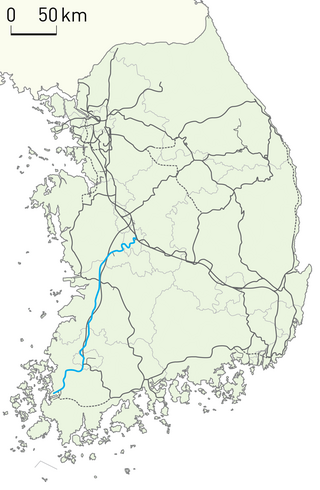
The Honam Line is a major railway line serving the Honam region in South Korea. The line is served by frequent passenger trains from Seoul to Gwangju and Mokpo.
The Honam Expressway is an expressway serving the Honam region in South Korea. The freeway connects Nonsan on the Nonsan-Cheonan Expressway and Honam Expressway Branch Line to Gwangju and Suncheon on the Namhae Expressway. The freeway's route number is 25. The Honam Expressway Branch, (호남고속도로의지선) is route number 251, and connects Nonsan on the Honam Expressway to Daejeon on the Gyeongbu Expressway.

Korea Train eXpress (Korean: 한국고속철도), often known as KTX, is South Korea's high-speed rail system, operated by Korail. Construction began on the high-speed line from Seoul to Busan in 1992. KTX services were launched on April 1, 2004.
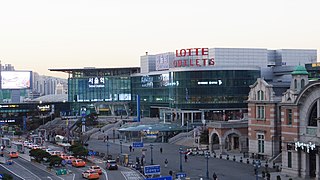
Seoul Station (Korean: 서울역) is a major railway station in Seoul, the capital of South Korea. The station is served by the Korail Intercity Lines and the commuter trains of the Seoul Metropolitan Subway.

Gyeryong is a city in southeastern South Chungcheong province, South Korea. The incumbent mayor is Choi Hong-Mook. The city was created in 2003 after being split from Nonsan following prolonged regional agitation.

The Mugunghwa-ho (Korean: 무궁화호) is a class of train operated by Korail, the main railway operator of South Korea. Mugunghwa trains are Korail's slowest tier of trains stopping at a number of towns and villages, and operating over a number of lines that are not served by other trains. Journey times are generally twice that of KTX trains and 25% longer than ITX express trains.

SuseoStation is a railroad station on the Suin–Bundang Line and Line 3 of the Seoul Metropolitan Subway. The station is in the Suseo neighborhood of the Gangnam District in Seoul, South Korea. Prior to the Line 3 extension to Ogeum station in 2010, Suseo Station was the southeastern terminus of Line 3. Along with Yangjae station, Suseo Station serves as an important transfer point between Line 3 and buses from/to southern cities such as Seongnam, Yongin, and Suwon.

Geumjeong Station is a ground-level metro station on lines 1 and 4 of the Seoul Subway network in South Korea. The station is in Gunpo, a city approximately 15 km (9.3 mi) south of Seoul in Gyeonggi Province, between the cities of Anyang and Suwon. The name means that the land is covered with waves everywhere and that the water wets women's clothes.

Tilting Train Express (TTX) or Hanvit 200 is a South Korean experimental tilting train, which is currently being tested by the Korea Railroad Research Institute (KRRI).

The Gyeongbu high-speed railway, also known as Gyeongbu HSR, is South Korea's first high-speed rail line from Seoul to Busan. KTX high-speed trains operate three sections of the line: on 1 April 2004, the first between a junction near Geumcheon-gu Office station, Seoul and a junction at Daejeonjochajang station north of Daejeon, and a second between a junction at Okcheon station, southeast of Daejeon, and a junction near Jicheon station, north of Daegu entered service; then on 1 November 2010, the third section, between a junction west of Daegu and Busan became operational. The missing gaps across the urban areas of Daejeon and Daegu were in construction for an expected opening in 2014, separate tracks into Seoul Station were also planned. The temporary ends of the three sections were connected to the parallel conventional Gyeongbu Line by tracks that will serve as interconnector branches upon the completion of the entire line. On 1 August 2015, construction on urban areas of Daejeon and Daegu were completed; all the sections of HSR line were connected.

The Honam high-speed railway, also known as Honam HSR, is a high-speed rail between Osong and Mokpo in South Korea. The line is a part of Korail's Korea Train Express (KTX) system, accelerating Seoul–Mokpo and Seoul–Gwangju KTX high-speed services which currently use the existing conventional Honam Line. On April 1, 2015, the line was inaugurated by the South Korean President Park Geun-hye with the attendance of 1200 invited guests and members of the public at Gwangju Songjeong Station in Gwangju, the line's terminus. The line diverges from Osong station on the Gyeongbu high-speed railway, and stops at Gongju, Iksan, Jeongeup Stations. Journey times between Seoul and Gwangju has been cut from 2 h 40 min to just 90 min, making daily commuting possible. The Honam HSR is intended to bring business, and economic opportunities to the province of Jeollanam-do, which has seen slower development than other parts of South Korea. The line has been open to the public since April 2, 2015 for revenue service.

Daejeon Station is on South Korea's high-speed KTX railway network, 166.6 km south of Seoul Station.
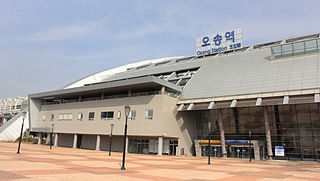
Osong station is a train station on the Honam and Gyeongbu high-speed railways in Cheongju City, North Chungcheong Province, South Korea. It is located at the intersection of the Gyeongbu KTX high-speed rail line, the conventional Chungbuk Line and, since April 2015, the Honam high-speed railway. KTX trains began calling there from November 1, 2010, bringing high-speed rail service to the nearby city of Cheongju.
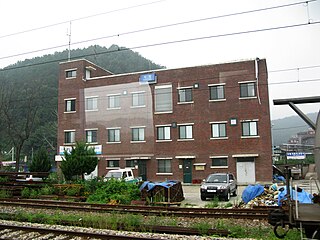
Seochang station is a signal box in Jochiwon-eup, Sejong City, South Korea.

Jochiwon station is a railway station in Jochiwon-eup, Sejong City, South Korea.

Iwon station is a railway station on the Gyeongbu Line in South Korea. It is located at Gangcheong-ri, Iwon-myeon, Okcheon-gun, Chungcheongbuk Province. It crosses the Gyeongbu Line which is managed by KORAIL. The station also operates trains on an interim basis for a memorial for railroad workers who died, which is located nearby.
Chupungnyeong is a mountain pass between Yeongdong-gun, Chungcheongbuk-do and Gimcheon-si, Gyeongsangbuk-do in South Korea.
High-speed rail service in South Korea began with the construction of a high-speed line from Seoul to Busan in 1992, and was inspired by Japan's Shinkansen. The first commercial high-speed rail service was launched on 1 April 2004. Currently, South Korea hosts two high-speed rail operators: Korea Train eXpress (KTX) and Super Rapid Train (SRT).
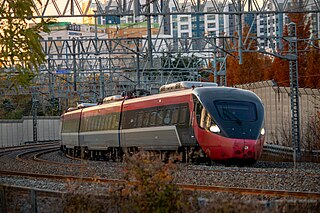
The Intercity Train eXpress-Saemaeul abbreviated as ITX-Saemaeul (Korean: ITX-새마을) is a class of train operated by Korail, the national railroad of South Korea, it was introduced on May 12, 2014, to replace the Saemaeul-ho. The new ITX-Saemaeul trains have a faster average speed of 150 kilometers per hour. The name was taken from the Saemaul Undong after a public competition to determine the new train's name.

















